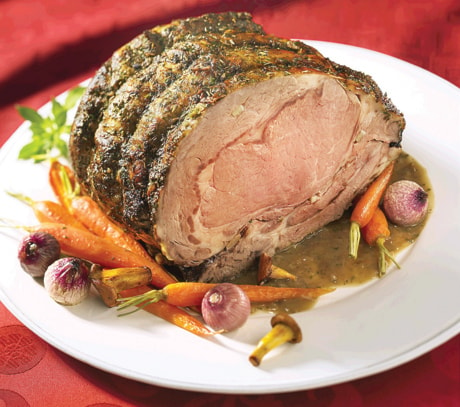All turkeyed out and Christmas hasn’t even arrived? This is the dilemma many families encounter each year, says Patrick Engel, a chef whose extended family has found themselves sitting down to not one or two traditional dinners over a short, but sometimes three or four.
“At one time, a huge turkey at Christmas was a splurge item when families were so much larger,” says the executive chef at The Good Earth Cooking School and Food Co. in Beamsville, Ont. “One could feed the whole family a big turkey back in the old days. Families are smaller now and with the proximity to Thanksgiving where serving turkey is not negotiable, the idea of cooking a 15-pound turkey might send them in another direction.”
Engel says the other change is in family dynamics.
Divorce and remarriage are the new norm in many families, so that you could conceivably end up having four Christmas dinners.
Engel and his wife once prepared a turkey on Christmas Eve, went to his parents for Christmas Day lunch, again for turkey, then to his wife’s family for, you guessed it, the big bird that night.Now on Christmas Eve, they host a seafood supper where they serve lobster and crab as well as a beef tenderloin or a prime rib roast.
“I think Christmas is about buying premium foods that you wouldn’t normally do,” he says, “and it’s a great excuse to have a beautiful meal and splurge.”
Engel and his wife decided that they would cook a turkey for her family on Christmas Day along with a side of salmon.
Engel says for those planning an alternative to the traditional gobbler, like a roast, sides can be root vegetables, greens such as brussels sprouts or chard.
“You don’t want every component of the meal to be heavy or roasted. Really scale down the quantity and serve a salad.”
If a splendid prime rib roast is the alternative main course to your festive dinner this year, here are recipes to try for both the meat course and a side of potatoes.
Slivers of garlic infuse the meat with rich, garlicky flavour while slow-roasting delivers delicious restaurant-style roast beef.
Thick-Crusted Prime Rib
3.15 kg (7 lb) prime rib premium beef oven roast
8 cloves garlic, cut into thin slivers
30 ml (2 tbsp) Worcestershire sauce
Salt and pepper, to taste
125 ml (1/2 cup) coarsely chopped parsley
50 ml (1/4 cup) Dijon mustard
30 ml (2 tbsp) each herbes de Provence or dried thyme
30 ml (2 tbsp) vegetable oil
Shallot Gravy (recipe follows)
Cut shallow slits all over roast; insert garlic slivers into slits. Rub all over with Worcestershire sauce, salt and pepper. In a bowl, combine parsley, mustard, herbes de Provence and oil. Set aside 30 ml (2 tbsp) of the mixture for Shallot Gravy, rubbing remainder all over roast.
Place roast, bones down, on rack in shallow roasting pan. Insert oven-safe meat thermometer into centre of roast. Roast, uncovered, in 230 C (450 F) oven for 10 minutes. Reduce heat to 140 C (275 F); roast until thermometer reads 57 C (135 F) for medium-rare to medium, 2 3/4 to 3 1/4 hours.
Remove from oven. Cover loosely with foil and let stand for 15 to 30 minutes before carving. Drain off all but 30 ml (2 tbsp) drippings from roasting pan and make Shallot Gravy.
Shallot Gravy: Place roasting pan over medium heat; add 3 shallots (coarsely chopped) and reserved herb rub. Cook, stirring, until shallots soften. Stir in 500 ml (2 cups) beef broth and 45 ml (3 tbsp) Worcestershire sauce; simmer, stirring up any browned bits from bottom of pan. Combine 15 to 30 ml (1 to 2 tbsp) cornstarch with equal amounts cold water, making smooth mixture. Gradually stir into broth; bring to a boil, stirring until thickened, about 3 minutes. Strain.
Makes 8 to 10 servings with leftovers.
Wine match: Australian Shiraz.
Recipe source: Beef Information Centre, www.beefinfo.org
Roasted Potato and Goat Cheese Bake
30 ml (2 tbsp) extra-virgin olive oil
2 shallots, thinly sliced
2 cloves garlic, chopped
4 round potatoes, chopped
2 small zucchini, thinly sliced
1 red pepper, chopped
15 ml (1 tbsp) chopped fresh thyme
45 ml (3 tbsp) balsamic vinegar
2 ml (1/2 tsp) each salt and pepper, divided
1 pkg (125 g/4 oz) goat cheese
5 eggs
250 ml (1 cup) half-and-half cream
In a large skillet, heat oil over medium heat. Cook shallots and garlic for 3 minutes or until softened. Add potatoes and stir to coat. Cover and cook, stirring occasionally, for about 15 minutes or until tender. Increase heat to medium-high and add zucchini, red pepper and thyme and cook for about 4 minutes or until golden. Remove from heat and add vinegar and half each of the salt and pepper. Cool slightly.
Spread vegetables in shallow 1.5-l (6-cup) greased casserole dish. Crumble goat cheese over vegetables. In a bowl, whisk together eggs, cream and remaining salt and pepper. Pour over vegetable mixture and bake in a 180 C (350 F) oven about 45 minutes or until knife inserted in centre comes out clean.
Makes 6 main servings or 8 side-dish servings.
Source: Ontario Potato Board, www.OntarioPotatoes.ca
